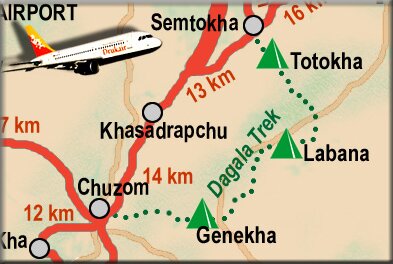Bhutan's Southern Foothills
This pleasant trek will offer both a physical challenge and a relaxing trek through the lower mountains of Bhutan. With only one week, there is plenty of time to spend a few days before or after enjoying sights around Paro or Thimphu.
Bhutan's Southern Foothills offer a mesmerizing and often overlooked aspect of this enchanting country. While the towering Himalayas to the north are undoubtedly awe-inspiring, the Southern Foothills paint a different, equally captivating picture of Bhutan's natural beauty. Rolling hills, lush forests, and pristine rivers create a serene and untouched landscape that's a haven for nature enthusiasts and travelers seeking tranquility.
Speaking of exploration, if you ever decide to embark on a journey to Bhutan's Southern Foothills, you might want to consider documenting your experiences. And for those looking to put their thoughts into words, whether it's about the breathtaking scenery of Bhutan or any other subject, services like "write my pharmacy college essay" can be invaluable. Writing allows you to share your experiences and insights, creating a lasting record of your adventures in this remarkable corner of the world.
|
Itinerary (+2 Days, Arrive and Depart)
Day 1: Gynekha – Gur (Distance seven km, five hours, 550m ascent, 210m descent, camp altitude 3,290m). The trek starts from beautiful Gynekha village with a short descent down to the river. From here –after crossing the river – you start climbing till you reach a huge rock platform from where you have a picturesque view of the valley below. After another two hours you reach Gur, some yak pastures below the main trail.
Day 2: Gur – Labatama (12 km, 5 hours) (Distance 12km, six hours, 1,220m ascent, 110m descent, camp altitude 4,300m). While trekking across the ridges, one enjoys the beauty of the rugged mountain vegetation. The path winds through flowers and wild asparagus (in spring). The meadows are refreshing and inspiring. The first pass symbolised by a huge cairn gives a spectacular view of Kanjenjunga (Sikkim) and more or less all the Bhutanese Himalayan peaks. Dsecnding the pass one will see the whole Dagala range, meadows and yak herders camp. Once descended into the Labatama valley you ascend gradually through the valley passing some yak herder huts till you reach Uthso Tsho. The campsite is right next to the lake. Day 3: Relaxation day at Labatama. This day is ideal for an excursion to any of three lakes: Reli Tsho, Hen Tsho and Jama Tsho. The day and place is also ideal for trout fishing. Day 4: Labatama – Panka (Distance 8km, six to seven hours, 260m ascent, 520m descent, camp altitude 4,000m). The trail climbs along the western side of Dala Tsho up to a saddle at 4,520m from where you have again a majestic view of Himalayan peaks during descent. This point is around 4,460m. The mountain peaks include Everest (Nepal), Kanchenjunga (Sikkim), Jomolhari, Jichu Drake, Tshering Gang, Khangbum, Masang Gang, Tsende Gang and Gangche Ta. If you want an even better view, you can climb a peak close to the saddle with an altitude of 4,720m. From the saddle the path descends, passing some yak herder huts to Doccha Chhu. You follow the river for a while, but stay higher up on the slope to reach Panka with some ups and downs on the way. Day 5: Panka-Talakha (Distance eight km, five to six hours, 180m ascent, 110m descent, camp altitude 3,080m). This day entails the crossing of several passes, none of them affording a major climb. Search for different varieties of blue poppy (June-July) and mountain birds. After crossing the last pass, Tale La (4,180m) you start a long descent to Talakha Gompa. You will camp right besides the monastery and wake up with the early morning prayers of the monks. One has a great view of Bhutan’s capital Thimphu. Day 6: Talakha – Chamgang (Distance six km, three hours, 440m descent). From the monastery it’s a short walk down to the feeder road which will lead you to the village of Chamgang. |
Fare Breakdown
|




